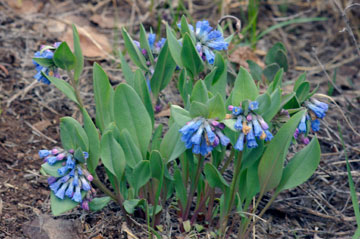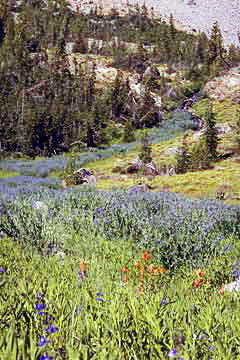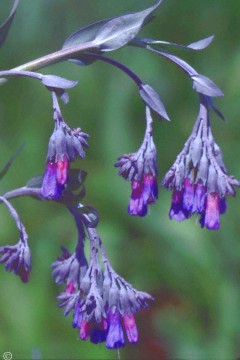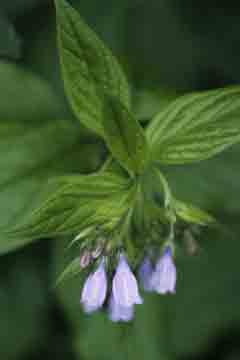 |
The Mertensias (Bluebells)
The Leafy bluebell, Mertensia
oblongifolia (Nutt.) G. Don. (left, right)
The leafy bluebell is one of the most common early spring
flowers. Its bright blue-to-purplish (rarely pink; or white) blooms are found
on sagebrush-covered foothills, appearing soon after the snow-melt to subalpine
elevations—the first blue flower to appear in the spring. The
name, oblongifolia reflects the plant’s wide leaves. All
mertensias have five sepals enclosing five petals. These form a tube that
flares more or less abruptly into the free part of the petals. This plant's
tube is longer and the flare less pronounced than in some of the other species.
The German botanist Karl Heinrich Mertens (1796-1830) collected plants while
on a Russian scientific expedition to Alaska in 1827. He applied the name
Mertensia to honor his father, Franz Karl Mertens (1764–1831),
also a botanist. The various mertensias grow primarily in northwestern North
America. |
 |
 |
Mountain or Ciliate Bluebell,
Mertensia ciliata
(James ex Torr.) G. Don
var. ciliata. The ciliate bluebell’s species name,
ciliata, means “fringed” because a fringe of fine hairs
can be seen on the margins of leaves when they are held up to the light.
The plants are found from mid- to sub-alpine elevations growing along
streambanks, often in prodigious numbers forming rivers of green and blue.
Typically the petals are longer than the tube and flare outward. Their color
is a delicate blue when they grow in shady areas, and brighter in the open,
especially at higher altitudes. The plants are several feet tall, the lush
leaves are deep green, elliptical to broadly lanceolate, and up to six inches
long. M. ciliata is a favorite browse plant for elk, deer, and other
animals, and it is common to find matted areas where large animals have bedded
down in the thick plant growth where they sometimes give birth to their
young. The common name "tall fringed bluebell" has been suggested
for this plant.
|
 |
 |
The Idaho Bluebell, Mertensia
campanulata A. Nelson. The
Idaho bluebell is a meadow plant, found only in central Idaho. It grows in
tallish clumps to montane elevations, sometimes in large patches (left).
Both the leaves and stems are bluish-green and have a frosted
(“glaucous”) appearance. The leaves are smooth, without prominent
veins. Its flowers are narrow and the break between the tube and the short
outer petals is less sharp than in other bluebells. These appear in late
spring and then die completely away in the summer’s heat. The word
campanulata means “bell-shaped,” a name that could apply
equally well to the flowers of most mertensias. (Note that the name
“bluebell” is used in other localities for various unrelated flowers,
emphasizing the importance of binomial scientific names.) |
 |
 |
Oregon bluebell, Mertensia
bella Piper
(left). The Oregon bluebell is the least common of the
several species of mertensia shown here, for, while it occurs in Idaho, Montana,
Oregon and California, it is considered to be an uncommon plant in all four
states; in Idaho it is found only in Clearwater and Idaho counties. It may
be identified by its thin, green leaves whose upper surface is covered with
fine hairs and the undersurface is smooth. The leaves’ veins are more
prominent than those of our other mertensias. The flowers are open and the
small lobes at the end are rounded. The plant is usually found in moist
surroundings, growing to mid-elevations in our mountains.
The Alpine Bluebell, Mertensia
alpina (Torr.) G. Don. (right) is
a small alpine plant, usually only four or five inches high with narrow leaves.
It grows at or above treeline. It is not common in Idaho and is found in
the higher mountains of the Centennial Range along the Idaho-Montana border
(Fremont County). Its flowers, while similar to those of other bluebells,
have a slender tube surmounted with joined, flaring petals. |
 |







